Lesson Plan > Lesson 30 > English
Elementary Level: Writing a Short Paragraph (Focus on Structure)
Mid Level: Narrative Writing (Story Writing Basics)
High Level: Figurative Language (Similes, Metaphors, Personification)
Elementary Level (Kinder to Grade 2)
Subject: Writing a Short Paragraph (Focus on Structure)
Objectives:
Children will write a simple paragraph with a topic sentence and 2-3 supporting details using guided sentence starters.
Alignment with Standards:
- CCSS.ELA-LITERACY.W.1.2 – Write informative/explanatory texts with a topic and some facts.
- CCSS.ELA-LITERACY.W.1.5 – Focus on a topic, respond to questions, and add details.
- CCSS.ELA-LITERACY.L.1.1 – Print all upper- and lowercase letters.
Lesson Plan
Materials Needed:
- Chart paper (pre-written paragraph example)
- Graphic organizer (hamburger paragraph template)
- Sentence starter strips (e.g., “My favorite animal is ____ because ____.”)
- Pencils, crayons, and writing paper
- Sticker rewards (for participation)
Lesson Activities:
1. Introduction (10 min)
- Read Aloud: Share a simple paragraph (e.g., “Dogs are great pets. They are friendly. They can play fetch. Dogs love their owners.”).
- Think-Pair-Share: “What is the main idea? What details tell us more?”
2. Modeling (10 min)
- Hamburger Paragraph Poster:
- Top Bun (Topic Sentence): “Cats are fun pets.”
- Lettuce/Cheese (Details): “They purr when happy. They chase toys.”
- Bottom Bun (Closing): “I love my cat!”
- Guided Practice: Complete a paragraph together (e.g., “The park is fun. I can swing. I can slide. I like the park.”).
3. Guided Writing (20 min)
- Sentence Starters: Students choose a prompt (e.g., “My favorite food is ___ because ___.”) and fill in the hamburger organizer.
- Scaffolding:
- Struggling Writers: Provide tracing words or word banks (e.g., “pizza, yummy, cheese”).
- Advanced Writers: Add a closing sentence (e.g., “That’s why I love pizza!”).
4. Sharing & Feedback (10 min)
- Students read paragraphs aloud. Praise specific elements: “Great topic sentence! I like your detail about ___!”
5. Extension (Optional)
- Illustrate the Paragraph: Draw a picture to match the writing.
- “Paragraph Puzzle”: Cut sentences apart and reassemble in order.
Assessment:

Visual Aids:
1. Hamburger Paragraph Template:
___________________________ (Top Bun: Topic Sentence)
___________________________ (Lettuce: Detail #1)
___________________________ (Cheese: Detail #2)
___________________________ (Bottom Bun: Closing) 2. Sentence Starter Examples:
- “I like ____ because ____.”
- “____ is my favorite place. You can ____ and ____.”
Adaptations:
- Kinesthetic Learners: Act out details (e.g., “Show me how you slide at the park!”).
- ELL Support: Use pictures with labels (e.g., clipart of foods/animals).
Mid Level (Grade 3 to 5)
Subject: Narrative Writing (Story Writing Basics)
Objective:
Children will craft a complete short story with a clear beginning (introduction), middle (problem/events), and end (resolution) using guided brainstorming and story starters.
Alignment with Standards:
- CCSS.ELA-LITERACY.W.4.3: Write narratives using descriptive details and clear event sequences.
- CCSS.ELA-LITERACY.W.4.4: Produce coherent writing for task and audience.
- CCSS.ELA-LITERACY.W.4.5: Develop writing through planning and revision.
Materials
- Story starter prompts (printed or digital)
- Graphic organizers (Story Mountain, BME Chart)
- Writing journal/paper
- Colored pencils (for illustrating)
- Timer (for quick writes)
- Peer feedback forms (Two Stars and a Wish)
Lesson Sequence
Day 1: Introduction & Brainstorming
Activity 1: Story Analysis (20 min)
- Read aloud “The Enchanted Umbrella” (a 1-paragraph model story).
- Discussion:
- “What hooks you at the beginning?”
- “How does the character solve the problem?”
- “What makes the ending satisfying?”
Activity 2: Story Starters (25 min)
- Students pick 1 prompt (e.g., “The message in the bottle said…”) and brainstorm:
- Characters: “Who is the hero/villain?”
- Setting: “Where does the story happen?”
- Problem: “What goes wrong?”
- Solution: “How is it fixed?”
- Visual Aid: Story Mountain Diagram showing plot structure.
Day 2: Drafting
Activity 3: Guided Writing (40 min)
- Beginning:
- Sentence starter: “As [character] [action], suddenly [surprise]…”
- Example: “As Mia explored the attic, suddenly a dusty book glowed!”
- Middle:
- Conflict prompt: “But then [problem], so [action]…”
- Example: “But then the book locked itself! So Mia searched for a key.”
- End:
- Resolution frame: “Finally, [character] learned [lesson].”
- Example: “Finally, Mia opened the book and discovered her grandma’s magic recipes!”
Tip: Encourage dialogue (“Wait!” shouted Mia) and sensory details (“The attic smelled like old peppermints”).
Day 3: Revising & Publishing
Activity 4: Peer Feedback (20 min)
- Swap stories and use Two Stars and a Wish:
- Two Stars: “I liked when…”
- One Wish: “Could you add…?”
Activity 5: Final Draft (30 min)
- Rewrite neatly and illustrate the climax scene.
Assessment Rubric

Visual Aids
1. Story Starter Prompts
- “The robot dog barked… but it wasn’t a bark. It was a—”
- “I planted the seeds at midnight. By morning, they’d grown into…”
2. Graphic Organizer Example
[Beginning]
Characters: ________
Setting: ________
Problem: ________
[Middle]
Events: 1. ______ 2. ______
[End]
Solution: ________
Lesson: ________ Differentiation
- Struggling Writers: Provide a fill-in-the-blank template.
- Advanced Writers: Add a subplot or flashback.
- ELL Support: Use picture aids + word banks.
High Level (Grade 6 to 8)
Subject: Figurative Language (Similes, Metaphors, Personification)
Objective:
Children will identify and apply similes, metaphors, and personification in writing by analyzing texts and rewriting sentences with figurative language.
Alignment with Standards:
- CCSS.ELA-LITERACY.L.7.5: Interpret figures of speech in context.
- CCSS.ELA-LITERACY.W.7.3.D: Use precise words and phrases, relevant descriptive details, and sensory language.
- CCSS.ELA-LITERACY.RL.7.4: Determine the meaning of words and phrases as they are used in a text, including figurative language.
Materials
- Figurative Language Anchor Chart (Definitions + Examples)
- Short Passages (From novels, poems, or songs)
- Task Cards (For practice exercises)
- Highlighters/Colored Pens (For annotation)
- Interactive Notebook Templates (For notes)
- Digital Option: Google Slides or Kahoot! Quiz
Lesson Sequence
Day 1: Introduction & Identification
1. Warm-Up (10 min)
- Play “Guess the Figurative Language” with famous quotes:
- “The world is a stage.” (Metaphor)
- “Her smile was as bright as the sun.” (Simile)
- “The wind whispered through the trees.” (Personification)
2. Direct Instruction (20 min)
- Anchor Chart Review:
- Simile: Comparison using like or as (“Brave as a lion”)
- Metaphor: Direct comparison (“Time is a thief”)
- Personification: Giving human traits to non-human things (“The flowers danced in the breeze”)
3. Guided Practice (20 min)
- Students highlight figurative language in short passages (e.g., Langston Hughes’s poetry or Tuck Everlasting excerpts).
Day 2: Application & Writing
4. Figurative Language Scavenger Hunt (15 min)
- Find examples in song lyrics (e.g., “Firework” by Katy Perry) or advertisements.
5. Rewriting Activity (25 min)
- Task Cards: Rewrite literal sentences figuratively.
- Literal: “The test was hard.”
- Figurative: “The test was a mountain I couldn’t climb.” (Metaphor)
6. Creative Writing (20 min)
- Describe a storm using all three devices (simile, metaphor, personification).
Day 3: Review & Assessment
7. Peer Review (15 min)
- Swap descriptions and identify each other’s figurative language.
8. Quiz (20 min)
- Matching, Multiple Choice, and Short Answer (Example: “Is ‘The stars winked at me’ a simile, metaphor, or personification?”)
9. Extension (Optional)
- Figurative Language in Media: Analyze a TV show clip for examples.
Assessment Rubric
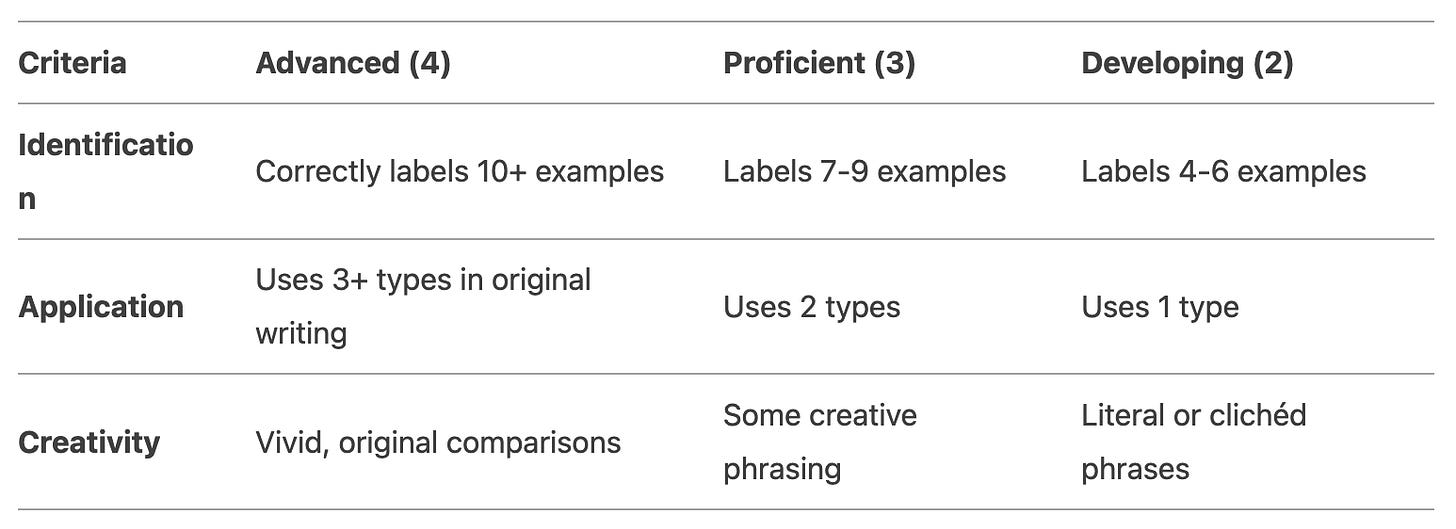
Differentiation
- Struggling Learners: Provide sentence frames (“The wind sounded like ___”).
- Advanced Learners: Write a micro-story packed with figurative language.
- ELL Support: Use visual prompts (e.g., angry clouds for personification).
Visual Aids
1. Anchor Chart Example:
SIMILE: "Her laugh was like wind chimes."
METAPHOR: "His words were daggers."
PERSONIFICATION: "The alarm clock screamed at me." 2. Task Card Sample:
“Rewrite this literally: ‘The car engine coughed and died.’”
→ “The car engine made a noise and stopped working.”
3. Image Aid:
[A gloomy house with windows like eyes and a door like a frown.]
Writing Challenge: “Describe this house using personification.”

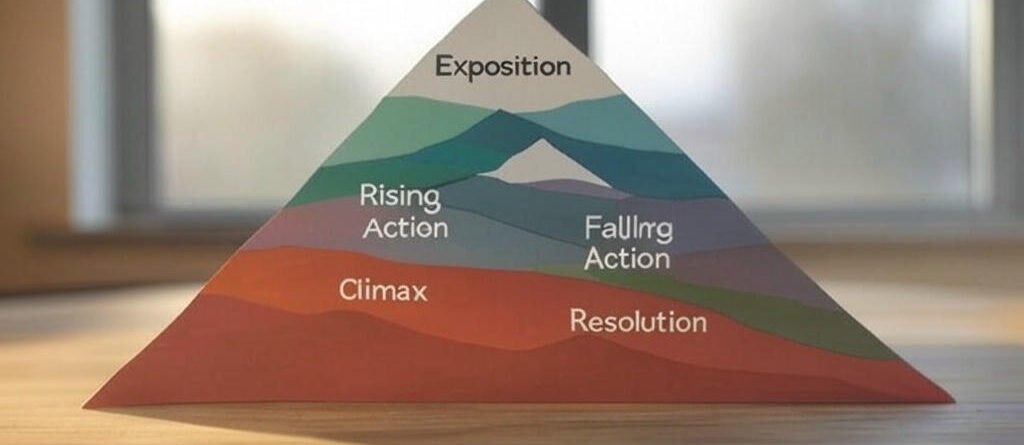

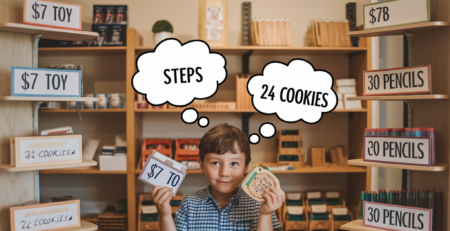

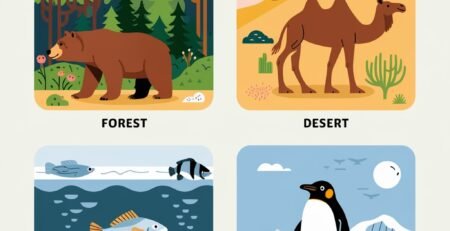
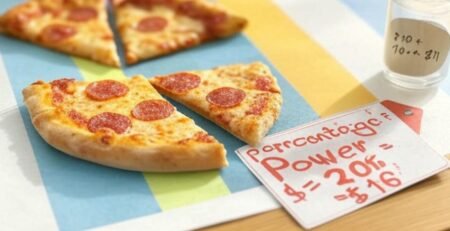

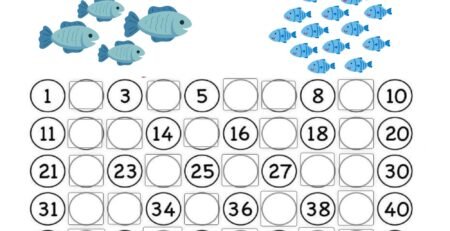
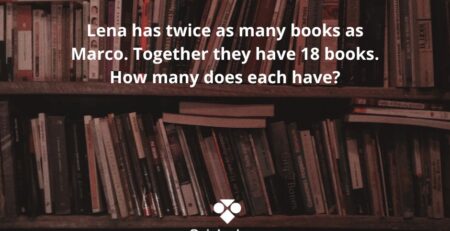
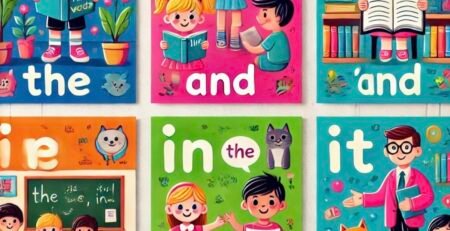
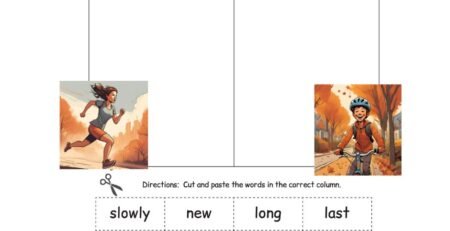

LEAVE A COMMENT